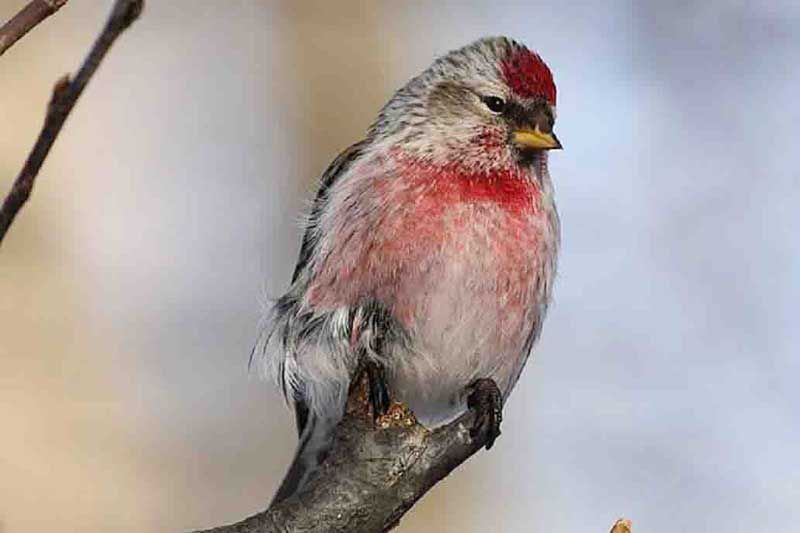Steve Blight | Feb 06, 2013
by Steve Blight
Now that we are just past the midpoint of winter, it looks like the stars of the winter birding show are the impressive numbers of redpolls being seen throughout the area. These little finches are plentiful at feeders, in weedy fields and in trees in many parts of southern Ontario and beyond this winter. Last weekend my wife and I were out in the Sharbot Lake area and there were plenty about – one flock on the Crow Lake Road must have numbered over a hundred.
Redpolls are about the size of our familiar Black-capped Chickadee, with black chins, red crowns, deeply forked tails and an undulating flight pattern. Adult male Common Redpolls have a rosy-pink breast, compared to the much paler breast of the female. Redpolls are circumpolar in distribution – they are found throughout the arctic in North America, Europe and Asia.
Redpolls got their name from the red patch on their heads. “Poll” is an old English word meaning “head”. One of our summer birds, the Blackpoll Warbler, was named in the same way – in what should come as no surprise these highly migratory wood warblers have black patches on their heads.
There are two species of redpolls in Canada – Common Redpolls and the much scarcer Hoary Redpoll. The two species are not easy to tell apart, but clues to help distinguish Hoaries are that they are much paler overall with a slightly smaller bill and an unstreaked rump. Frankly, I have never been able to positively identify a Hoary among a flock of redpolls with all the natural variations present among males, females and immatures.
Redpolls nest in low trees and shrubs in the far north. Their breeding range just barely extends southward into Ontario, where they breed along the Ontario shore of Hudson’s Bay. In summer they feed on a mix of insects and seeds, including seeds of grasses, sedges, and trees like alders and birches.
Redpolls are active foragers that travel in busy, chatty flocks. They migrate erratically, and they occasionally show up in large numbers as far south as the central U.S. Common Redpolls are White Birch specialists. White Birch has good seed crops about every two years with some seed most years. When birch catkins are loaded with seeds across the north, redpolls remain in the boreal forest. When the birch seed crop is poor in the north they move out in huge numbers in search of good food supplies. During such irruption years, redpolls often congregate at bird feeders – particularly those stocked with nyjer and black oil sunflower seed – allowing delightfully close looks through binoculars.
This year it was expected that there would be a good southward flight because the white birch seed crop was poor to fair across the north. Sure enough, beginning in early winter the redpolls began being observed in large numbers. Some observers have noticed that numbers have begun to fall off slightly from peaks earlier this winter, perhaps as a result of movement further south in search of food.
Their erratic movements make it hard to accurately determine the conservation status of redpolls. However, there doesn’t appear to be any significant movement either up or down in their numbers. I think it safe to say that these gregarious little finches will continue to brighten our winters for years to come.
Please feel free to report any observations to Lorraine Julien at This email address is being protected from spambots. You need JavaScript enabled to view it. or Steve Blight at This email address is being protected from spambots. You need JavaScript enabled to view it.
More Stories
- No Winner Yet in Catch The Ace But Fundraising Target Met
- South Frontenac Food Bank Opens Second Location in Battersea
- Sharbot Lake Pentecostal Church Anniversary - 1925-2025
- Frontenac Holistic Health Fair - September 20 At Storrington Centre
- Odd Year For Real Estate - But Sales Are Steady Year Over Year
- 193rd Kingston Fall Fair
- Kim Phuc - the Napalm Girl - To Visit Flinton In November
- South Frontenac Council - September 2
- Sticker Shock - EV Charging Station To Cost North Frontenac Township
- 30th Anniversary Verona Car Show

